Project Log: Saturday,
February 6, 2010
Home Page >
The Project >
Project Logs > 2/6/10 |
During the initial
demolition-fest, I'd elected to leave the cabin sole in
place to allow for easier access through the cabin.
Having the sole in place certainly made much of the interior
preparation and grinding work easier.
Additionally,
there remained vestiges of the old structure, namely the
bottom section of the longitudinal bulkhead that had been
located beneath the mast step, and the adjacent sections of
bulkhead that defined the old head. Additionally,
there was a water tank built into the keel aft of the
internal ballast pigs. These remaining structures had
to go.
|
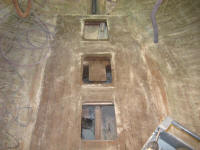 |
I started by cutting out the cabin sole in a few
sections, beginning with the largest aft section. With
a circular saw set to a depth of cut slightly more than the
sole was thick, I cut down the centerline, then down each
side as close to the curvature of the hull as I could, and
transversally across the sole at the forwardmost hatch
opening. These pieces came out with ease, and
afterwards I found that minimal prying caused the remaining
plywood and polyester tabbing to come cleanly away from the
hull without much effort. |
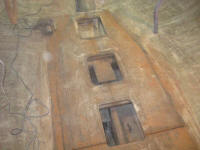
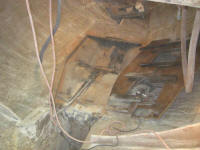
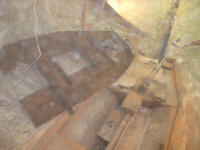 |
After clearing away the debris, I continued forward
and cut out the forward sections of the sole. I'd been
hoping for a repeat of the ease with which the after
sections came out, but the Allied Inverse Structure Theory
had been practiced in the forward sections: the narrow
sole here was much more secure than the aft portion.
I'd hoped that by cutting d own the centerline, I'd have
enough leverage to rip the sole and tabbing away from the
hull at the edges, but that was not to be. The tabbing
appeared to be heavier and much more secure than the after
part. |
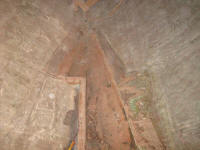 |
Removal was further complicated (read:
time-extended) by the way the sole veneer was secured to the
curvature of the hull. I found that the veneer, which
had peeled up cleanly at the aft end of the boat, was
tenaciously secured to the hull with significant amounts of
whatever aquamarine-colored, rock-candy consistency resinous
adhesive Allied used throughout the boat's construction (as
previously seen during the overhead liner removal). |
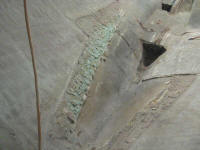 |
Eventually, I used a wide chisel to remove the
veneer and much of the brittle adhesive from the hull,
exposing the tabbing and allowing me to cut through it at
the edges. But there remained behind much adhesive and
rough tabbing edges for later grinding.
With all of
the cabin sole out of the way, I turned to the water tank.
But before I cut out the tank, I decided to remove the
awkward centerboard cable arrangement that was in place.
This consisted of a bronze pipe leading from the lift sheave
box at the top of the centerboard trunk, above the water
tank through a recessed groove, and into a heavy, angled
block made up of dense resin and fiberglass.
Long-removed from this boat was the top portion of this
arrangement, which featured a flange that bolted to the flat
top of this box, with another tube leading up towards the
cockpit-mounted winch.
In any event, I'd reconfigure
this all later: I saw no reason to stick with this
original setup given the sweeping changes to the boat, and
anyway it looked like the heavy glassed-in block was likely
to end up right in the way of future engine foundations.
With a reciprocating saw, I removed the bronze pipe, and
then cut around the heavy block as much as I could; a
sledgehammer too care of the rest, leaving behind a
substantial chunk of gunk that I'd attack with cutoff discs
and grinder later.
Boot included for scale. The
fourth picture shows the block after I cut it away; the boot
points to its original location just inboard of the end of
that bulkhead. |
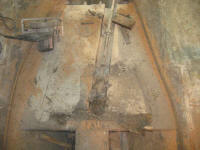
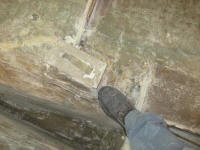
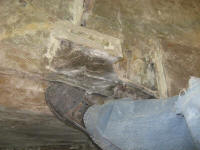
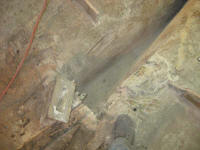 |
Now for the water tank. The top of the tank
was a remarkably flimsy section of molded and gelcoated
fiberglass, not worthy of weight-supporting. I used
the reciprocating saw to begin cutting out the tank around
the edges where it was tabbed to the hull.
Of course,
at some point--maybe several points--during the weeks
leading up to this moment I contemplated whether there might
be any water in the tank, but it didn't occur to me again
until, as I cut down the forward edge of the tank, water
began to pour out around the saw blade. I had to drill
a couple holes at the very bottom of the tank in the bilge
and allow the water to drain out; it was about 3/4 full, and
took a long time to drain through a 1/2" hole. |
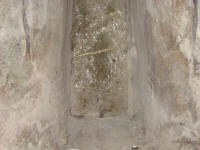 |
Once the tank was drained, I cut out the remainder
in several steps, including both the forward and after
bulkheads I'd have to rebuild the forward bulkhead
later, as I felt that it was of structural import, given its
location spanning the hull directly aft of the centerboard
lifting sheave, but that was for later.
For
some reason, I was surprised to find that the centerboard
trunk extended all the way to the aft bulkhead that defined
the tank; I'd never really had reason to consider the
overall length of the trunk. The water tank was
disgusting inside. I hope no one drank out of this
thing. The hull formed the outside of the tank, and
had been coated with something or other that had sloughed
off into the tank in brown sheets. I cleaned out the
detritus and moved on. |
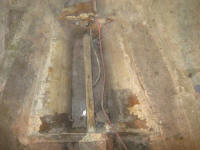
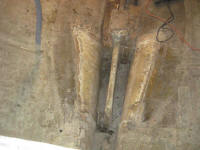 |
Next, I cut out the remaining bits of the bulkheads
in the head/mast step area. This went much more easily
than I'd expected, particularly since the 2" thick plywood
longitudinal bulkhead didn't extend all the way to the
bottom of the hull as I'd expected, which meant that cutting
the tabbing was easy, what with the air space beneath.
The space beneath contained some water and indefinable
debris; the base of the plywood was black-stained from
water, but otherwise firm and sound. In any event, it
was good to see it go. |
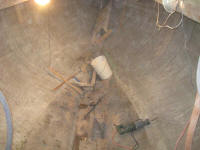
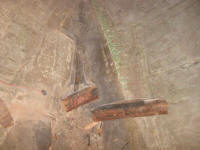 |
While I was at it, I also
cut off three U-bolts and one eye bolt that were cast into
the top of the internal ballast, all of which were badly
rusted and served no purpose whatsoever.
I cleaned up
the remaining debris, and called it a day. Next
there'd be more grinding to clean up the tabbing edges and
so forth left over from the day's efforts. |
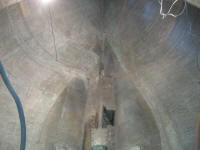
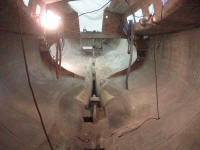
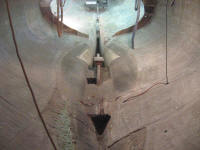
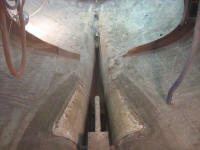
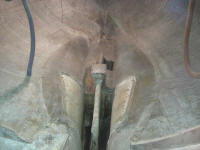 |
Total Time Today: 4.5 hours |
Previous |
Next |
|
|